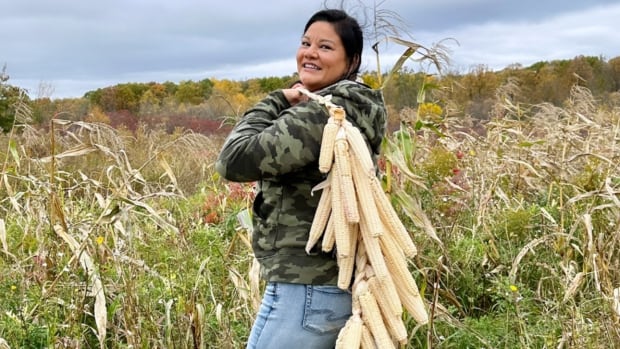This past weekend, I joined Six Nations community members to harvest corn and prepare it for winter storage.
White corn is one of the main forms of sustenance for Haundenosaunee people and Six Nations Health Services holds traditional food events throughout the year in the community near Hamilton, Ont.
They’re not just about learning how to harvest and prepare traditional foods; it’s also a chance for people to connect with each other and reconnect with our culture through food.
It’s about “having people come out, being together, laughing together, working together, learning something new, learning something old,” Arli Harrison told me over a bowl of corn soup and scone.
As Six Nations Health Services’s life promotion co-ordinator, she runs programming to support healthy living and suicide prevention.
I’ve attended the white corn harvest in the past but this time around, I was hoping to improve my corn braiding technique. The corn is braided by the husks so that it can be hung to dry.
Last year, my braid loosened and the corn was too heavy to hang, even as it dried, so my corn was relegated to a Rubbermaid bin.
The corn harvest is the last traditional food harvest of the year. The growth of the corn determines when Longhouse ceremonies are held. There are two times when the corn is acknowledged in the Longhouse: Small Green Corn, when early vegetables and fruits are harvested, and Big Green Corn, which culminates the fall harvest, the final ceremony of the year.

White corn is one of the three sisters — corn, beans and squash — tyonnhéhkwen in Kanien’kéha (Mohawk language), which translates to “our sustenance” or “life sustainers.” The three sisters are acknowledged in the Thanksgiving Address — a prayer said at every Longhouse ceremony and before every social gathering.
White corn is so vital to Haudenosaunee culture it’s even part of our creation story.
Traditionally the three sisters were planted together in a hillock representing the pregnant belly of Skywoman, who in the Haudenosaunee creation story, first gave the three sisters to our people.
As the corn grows taller, it’s supported by the beans growing up their stalks, which also provide nitrogen to the soil, while the weeds are inhibited by the growth of the squash, which provides shade and moisture for the soil as its runners spread out across the hillock. The three sisters support each other like family.
Harvesting the corn
Harrison told me the corn must be dry before it is harvested, so I looked for yellow stalks and avoided the cobs with any green which are still too fresh to pick.
It was a blustery day in the cornfield but I warmed up carrying my bushel basket around, the fuller it got.
Then we cleaned the corn of its husk and any bad kernels before it is braided. I’m told to leave only three husks on for the braids — any more than that and my braid will be too loose and bulky.
Now I know where I went wrong previously.
The long sturdy braids must then be hung to dry for the year. Traditionally, they were hung in the Longhouse to dry. The best corn kernels are saved to be planted the following year.
During this time while the corn is drying, it’s important for it to be shielded from negative energy as it carries the seeds of the next generation, according to Haudenosaunee teachings.
Debora Martin, who is Bear Clan, Kanien’kehá:ka (Mohawk) and Bonnie Skye, who is Turtle Clan, Kanien’kehá:ka, both from Six Nations, host workshops in schools about traditional white corn preparation and its teachings.
“The young people, they’re asking for their language, they’re asking how to garden, how to pick the corn, how to lye the corn, how to make mush,” said Martin.

Martin and Skye woke up early to prepare corn soup and scone for the community corn harvest.
This simple soup of white corn, kidney beans and salt pork (a throwback to the rations we received from the Canadian government when we were first put on reserves) is a staple at most powwows and social gatherings.
Martin and Skye also shared their teachings with the group beginning with an important food preparation technique called lying or washing the corn.
Corn must be lyed — cooked in lime water, a solution made from combining hardwood ash or baking soda and water, to remove the outer layer of the kernel. This process, called nixtamalization, increases the nutritional benefits of corn as well as its shelf life.

Every part of the corn is used by Haudenosaunee.
Martin and Skye teach how the kernels can be lyed for soups, coarsely ground for mush and mixed with berries and maple syrup or meat, and more finely ground for flour to make traditional cornbread.
The corn silk can be steeped in tea. Good clean pieces of corn husk are made into corn husk dolls (or no-face dolls) meant to teach children about humility. The husks are also twisted into cord for door mats.
“I was told when you have it on your porch or even hung, that’s to keep negative energy out of your home,” said Martin.
I learn something new every year, namely, that our food is medicine as well as nourishment.
Although Martin did most of my braid, this year I can be certain it will hold and sometimes it’s OK to lean on community for support.


